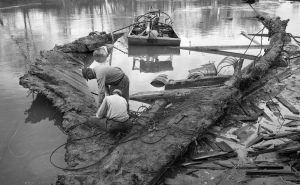
KINSTON, N.C. — While much of the remnants of the ironclad CSS Neuse can be seen on display in downtown Kinston, parts of it still remains submerged in the Neuse River. Archaeologists from the N.C. Underwater Archaeology Branch will use the latest modern technology May 13 to recover remnants of the vessel that was destroyed in March 1865.
The CSS Neuse was constructed in Whitehall, now known as Seven Springs, and completed in Kinston in 1863. She was launched in 1864 with the intention of steaming to New Bern, which had been occupied by Union troops since 1862. The ship ran aground on a sandbar and eventually was floated back to Kinston until March 1865 when she was blown up by her crew to prevent capture by the Union. Early in the 1960s recovery efforts began, and in 1964 most of the ship was salvaged and brought to the site of the Governor Richard Caswell Memorial. In June 2012 the vessel was moved to the CSS Neuse Civil War Interpretive Center on the corner of Queen and Caswell Streets in Kinston.
“It’s very significant because this is the only commissioned Confederate ironclad left from the Civil War,” Site Manager Matthew Young explained. “We know there are sections of the ship still in the river; we don’t know how significant they are to our understanding of its construction or operations. There may be pieces of iron plate, a propeller, or even an anchor still in the river.”
A 10 a.m. pre-launch briefing at the boat ramp off Highway 70 will start the work between the King Street and Queen Street bridges. This will be the third attempt at recovery.
“The Neuse River is in great condition for this project right now,” said Deputy State Archaeologist John “Billy Ray” Morris. “The river is at the right depth for this research and the weather is excellent.”
The river survey is a cooperative project of the Office of State Archaeology and the Division of State Historic Sites within the N.C. Department of Cultural Resources. High waters and heavy rains prevented two earlier attempts. Archaeologists will use the 23 foot boat, R/V Snap Dragon to patrol the river for several hours. “This will be the first detailed survey of this part of the river using modern side sonar, a magnetometer, and ad differential Global Positioning System,” Morris continued.
“We are hoping this survey will tell us what, if anything, is salvageable,” said Historic Sites Division Director Keith Hardison. “We need to gather information so we can explore the possibility of recovering additional pieces of the ship to add to the CSS Neuse Civil War Interpretive Center in downtown Kinston.”
Donations to support this effort are encouraged. The CSS Neuse Interpretive Center is located at 100 N. Queen St. in downtown Kinston. Hours are Tuesday-Saturday, 9 a.m. to 5 p.m. The Governor Caswell Center is at 2612 W. Vernon Ave., Kinston. Hours are Tuesday-Friday,10 a.m. to 2 p.m. and Saturday 10 a.m. to 4 p.m.
For information, please contact Site Manager Matthew Young at (252) 526-9600 or email [email protected]. Visit the site on Facebook at “CSS Neuse” or “Gov. Richard Caswell Memorial State Historic Site” pages. The CSS Neuse Civil War Interpretive Center and the Gov. Richard Caswell Memorial are within the Division of State Historic Sites of the N.C. Department of Cultural Resources.
Source: Edited from a press release of the North Carolina Department of Cultural Resources.
Cover Photo, Top Left: Recovery efforts at the CSS Neuse in the 1960s. Courtesy North Carolina Department of Cultural Resources.
_______________________________________________
Read about the most fascinating discoveries with a premium subscription to Popular Archaeology Magazine. Find out what Popular Archaeology Magazine is all about. AND MORE:
On the go? Purchase the mobile version of the current issue of Popular Archaeology Magazine here for only $2.99.
Popular Archaeology’s annual Discovery Edition eBook is a selection of the best stories published in Popular Archaeology Magazine in past issues, with an emphasis on some of the most significant, groundbreaking, or fascinating discoveries in the fields of archaeology and paleoanthropology and related fields. At least some of the articles have been updated or revised specifically for the Discovery edition. We can confidently say that there is no other single issue of an archaeology-related magazine, paper print or online, that contains as much major feature article content as this one. The latest issue, volume 2, has just been released. Go to the Discovery edition page for more information.





